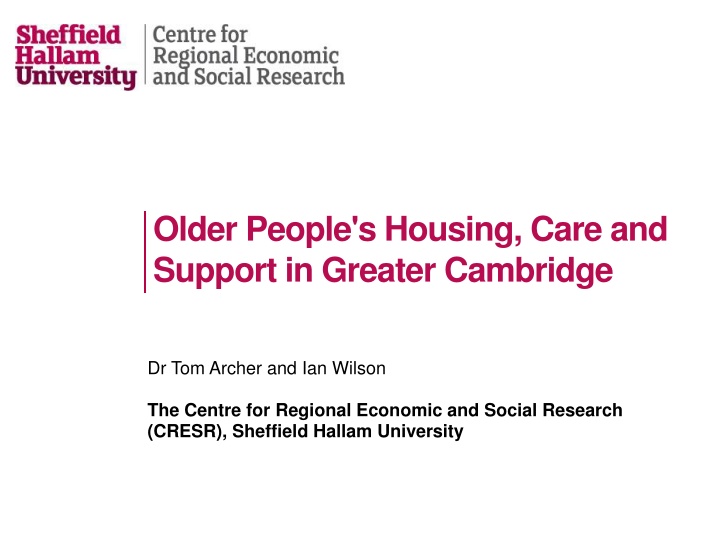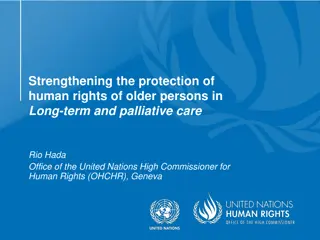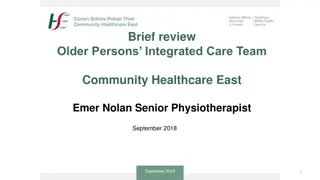Future Trends in Older People's Housing, Care, and Support in Greater Cambridge
A research project by Dr. Tom Archer and Ian Wilson at Sheffield Hallam University aims to project the future demand and supply of older people's housing in Greater Cambridge. By developing a better model of supply, they aim to address shortfalls in age-exclusive housing and care beds. The study forecasts future supply levels and tenure options, providing insights into residents' preferences and decision-making processes regarding housing in later life.
Download Presentation

Please find below an Image/Link to download the presentation.
The content on the website is provided AS IS for your information and personal use only. It may not be sold, licensed, or shared on other websites without obtaining consent from the author.If you encounter any issues during the download, it is possible that the publisher has removed the file from their server.
You are allowed to download the files provided on this website for personal or commercial use, subject to the condition that they are used lawfully. All files are the property of their respective owners.
The content on the website is provided AS IS for your information and personal use only. It may not be sold, licensed, or shared on other websites without obtaining consent from the author.
E N D
Presentation Transcript
Older People's Housing, Care and Support in Greater Cambridge Dr Tom Archer and Ian Wilson The Centre for Regional Economic and Social Research (CRESR), Sheffield Hallam University
Project aims To project the future demand for, and supply of, older people's housing. To policy and practice across the range of services areas related to older people's housing, care and support To provide insights into resident's preferences, perceptions and decision-making in terms of housing in later life
Developing a better model of supply Established models (e.g. SHOP@) estimate the future need for specialist housing and residential/nursing care These have been criticised as they are based on prevalence rates and encourage development of certain housing types The CRESR model is based on current provision in local authorities with the highest level of supply. Hence, it is grounded in what is possible Using data from 100 high-supply authorities we establish the predictors of variation in supply. This enables us to recommend certain levels of supply given local conditions
The supply of older people's housing There are current shortfalls in the supply of age-exclusive housing, specialist housing and care beds The large deficits are in sheltered and age exclusive housing suggest there is scope to expand and refine housing with low-to-no support Recommended Current supply 239 3,280 2,945 Difference supply 1,145 3,422 3,057 Age exclusive Specialist Housing Sheltered Enhanced Sheltered Extra Care Care beds (906) (142) (112) (42) 90 48 275 287 12 2,152 1,825 (327)
The future supply of older people's housing 6,500 6,000 Age exclusive 5,500 5,000 Specialist Housing 4,500 4,000 Specialist: Sheltered 3,500 3,000 Specialist: Enhanced Sheltered 2,500 2,000 Specialist: Extra Care 1,500 1,000 Care beds 500 0 2016 2020 2025 2030 2035
The future tenure of older people's housing The CRESR model projects large percentage increases in ownership units, but in numerical terms much more in the form of rented options. This is a very different picture to SHOP@'s projections Recommended supply 2020 2025 1218 1493 103 2960 3627 569 57 47 277 41 2016 1055 2030 1692 143 4111 790 2035 1901 161 4619 887 88 73 432 64 Rented Owner Rented Owner Rented Owner Rented Owner Age exclusive 89 126 2564 492 49 41 240 35 Sheltered 697 69 57 339 50 79 65 Enhanced Sheltered 384 57 Extra Care
Appraising sites for future demand Using the outputs of the CRESR model, alongside new analysis of moving distances to local extra care schemes, we have developed an equation to assess demand on a given site This recommends a given number of over 75s in a specific travel zone to support a 40 unit scheme
An inter-linked system of provision Housing assistance to promote well- being and independence New housing providing lifetime homes and age friendly neighbourhoods Information and advice to make the best decisions about housing and support Choice in specialist housing, including options to rent and own Health and Social care promoting well- being and independence across housing options
Insights from stakeholders and residents Information and advice is critical to people making more informed choices. Potential to build on the HOOP pilot, connecting up related services, and educating non-housing professionals The process for managing home modifications shows inefficiencies. Yet resident assert importance of this service There are clear challenges in building new general needs accommodation to certain specifications (e.g. Part M4(2)). Northstowe is an opportunity to show commitment and viability Large retirement housebuilders see Greater Cambridge as a 'hotspot' area, but barriers exist in land markets and planning There is potential to enhance multi-disiplinary working. Specific challenges in terms of hospital discharge, and supporting those living with dementia
Key opportunities to improve the system of provision Improving advice and information, but there is need to understand its impacts on other provision. Establishing the impact of home modifications in mitigating demand on other services, and helping target investment. Using local authority assets and mechanisms to build and/or commission housing to meet gaps in supply Creating opportunities for providers to develop low-to-no support housing which is age appropriate, and removing barriers to private sector engagement Using emerging policy agendas and associated funding to integrate housing, health and care
Unpicking the links between interventions Reduces demand on care beds by 5%, increases demand on specialist by 4% More people housed in appropriate specialist housing rather than care settings (140 people) Increases demand for specialist housing by 15% - 900 units by 2035 Supply of residential / nursing care Comprehensive housing options service (akin to North Manchester) Supply of specialist housing Improved perceptions of specialist from within general needs (1% older people in general needs demand specialist housing) Creates 11% increase in demand for specialist Delaying entry into specialist and residential care (e.g. by up to four years (Smith, 2016)) Increased investment in home modifications























